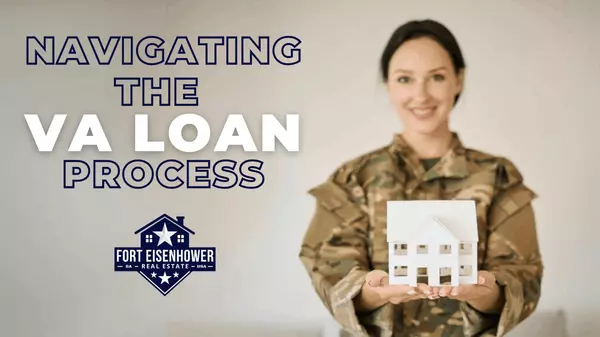Mastering Your Budget & Military-Specific Financing Options for Homebuyers

Buying a home can be overwhelming for anyone. For military families, it's even more of a challenge. You face some unique challenges—and opportunities—that others don’t. But here’s the thing—homeownership doesn’t have to be overwhelming if you’re prepared and take advantage of the tools available to you.
Having a budget in place from the start is key. Why? Because when you know exactly what you can afford and what financing options are out there, it puts you in control. You don’t want to fall in love with a house that’s out of your price range or, worse, make a bad financial decision because you didn’t plan ahead.
A well-thought-out budget—plus leveraging military-specific benefits like the VA loan—can be a total game-changer. Trust me, after going through seven PCS moves, I’ve seen firsthand the difference a little preparation can make. It can be the difference between stress and success in your homebuying journey.
Let’s break it all down so you can start this journey feeling confident!
Assessing Your Financial Situation
Reviewing Your Income
The first step to creating a solid homebuying budget is to figure out exactly how much money is coming in each month. For military families, this can be a bit tricky (in a good way) because your income isn’t just about your Base Pay. You’ve also got BAH (Basic Allowance for Housing) and other allowances that vary depending on where you’re stationed.
BAH is a huge perk when it comes to buying a home. It’s designed to cover your housing costs, which means it can make a big difference in what you can afford. But, don’t just rely on BAH to carry your budget. Make sure to account for your total income—Base Pay, BAH, and any other special pay or allowances. This gives you a full picture of what you’re working with.
Be cautious about special pay or allowances. If that money is something that can fluctuate or may go away, it may be better to exclude that from your budget math.
Tracking Expenses
Next up: your expenses. It’s easy to overlook those little costs that pile up, but they add up fast. Sit down and look at everything you spend money on each month, from groceries to gas to those random Amazon orders. You need to know what’s leaving your bank account just as much as what’s going in.
Once you have a good handle on your expenses, you can start figuring out how much you can comfortably spend on a mortgage. Remember, you don’t want to stretch your budget so thin that you’re living paycheck to paycheck in your new home.
Considering Debt
Debt plays a huge role in what kind of loan you’ll qualify for. If you’ve got student loans, car payments, or credit card debt, it’s going to impact how much house you can afford. Lenders look at your debt-to-income ratio (DTI) to figure out if you’re a risky borrower. The lower your DTI, the better your chances of getting approved for a loan with a good rate.
It’s not just about paying down debt to qualify for a loan—it’s about making sure your mortgage fits into your life without putting you in a tough financial spot. If you have debt, start making a plan to pay it off or at least lower it before jumping into the homebuying process.
Building Savings
Even if you’re planning to use a VA loan with no down payment, having some savings set aside is crucial. Things like closing costs, moving expenses, and unexpected repairs can catch you off guard. Trust me, the last thing you want is to scramble for cash right after you’ve just bought a home.
Building up a savings cushion also helps ease the stress of those “what if” moments. What if something goes wrong with the house? What if your PCS orders change? Having some money set aside can give you peace of mind and flexibility.
Creating a Realistic Budget
Now that you’ve reviewed your income, tracked your expenses, considered your debt, and built some savings, it’s time to put it all together. Creating a realistic budget means being honest with yourself about what you can truly afford. Use your BAH as a guide, but don’t forget to account for other expenses like utilities, property taxes, and insurance.
Pro tip: Always budget a little extra for the unexpected. Military life is full of surprises—so having a bit of wiggle room can save you from financial headaches down the road. A realistic budget lets you enjoy your new home without constantly stressing about money.
Understanding Your Buying Power
Calculating What You Can Afford
Alright, now that you’ve got a handle on your budget, it’s time to figure out how much home you can actually afford. One of the easiest ways to do this is by using an online mortgage calculator. Plug in your income, expenses, and expected loan terms to get a ballpark figure. Keep in mind that just because a calculator says you can afford a certain amount doesn’t mean that’s the amount you should spend.
Here’s the rule: stay within your comfort zone. You don’t want to be house-poor, meaning all your money is tied up in your mortgage with nothing left over for the rest of life. Just because you’re approved for a big loan doesn’t mean you need to max it out.
Debt-to-Income Ratio (DTI)
Lenders are going to look closely at your debt-to-income ratio to decide how much they’re willing to lend you. This ratio compares your total monthly debt payments to your gross monthly income. Ideally, you want to keep your DTI under 36%. The lower your DTI, the more likely you are to qualify for a better mortgage rate.
Here’s the kicker: you can control your DTI by either lowering your debt or increasing your income. Before applying for a mortgage, see if you can knock out some high-interest debt (like credit cards) to boost your chances of getting a great loan.
Pro tip: Keep in mind how paying off a debt may impact your credit score. In some cases, your credit scores may go down slightly depending on your credit mix, credit utilization ratio, or length of credit history.
Factoring in BAH
Your BAH is one of the biggest advantages you have as a military homebuyer. It’s tax-free income specifically meant to cover your housing costs. In many cases, your BAH can be used to pay for your entire mortgage, depending on where you’re stationed.
However, keep in mind that BAH varies based on location, rank, and whether you have dependents. If you get PCS orders to a higher-cost area, your BAH might increase, but so will housing costs. The key is to figure out how much house you can afford based on your current BAH, but always leave a little buffer in case your orders change.
Down Payment Considerations
Here’s where things get interesting: if you’re using a VA loan, you don’t have to put any money down. That’s one of the biggest perks of the VA loan program. But just because you can buy a house with zero down doesn’t mean you should.
In some cases, making a down payment can be a smart move. A down payment reduces the overall size of your loan, which means lower monthly payments and less interest over time. Plus, putting some money down upfront gives you instant equity in your home. This can be particularly helpful if you need to sell in a few years before your next PCS.
Using a VA loan, your funding fee will change based on your down payment and if you've used your entitlement before. Funding fee rates range from 1.4% to 3.6%, which means thousands of dollars. So, if you’ve got the cash saved up, consider putting down at least 5% to 10% ( if it's within your budget) to save some money.
Additional Costs to Consider
It’s not just the mortgage payment you need to think about. There are plenty of other costs that come with homeownership. Property taxes, homeowners insurance, and maintenance can sneak up on you if you’re not prepared.
Here’s a quick rundown of what to expect:
- Property Taxes: These vary by state and county, so make sure to factor them into your monthly budget.
- Homeowners Insurance: Required by lenders, this protects your home and belongings from damage or loss.
- Maintenance: You’re responsible for upkeep, which could be anything from mowing the lawn to fixing a broken water heater. Consider the age of the home and equipment, too. Major appliances and things like your roof have a limited lifespan.
The goal is to make sure you’re not stretched thin by these additional costs. Always budget for a little more than just your mortgage payment to cover these expenses comfortably.
VA Home Loan Benefits and Requirements
What is the VA Loan?
The VA loan is hands down one of the best benefits available to military families. It’s a loan program backed by the Department of Veterans Affairs that helps service members, veterans, and their families buy a home with no down payment, no private mortgage insurance (PMI), and often better interest rates than conventional loans.
What does this mean for you? It means you can get into a house without having to save tens of thousands of dollars for a down payment. Plus, you won’t have to pay PMI, which is a fee that most lenders charge if you put down less than 20%. This alone can save you hundreds of dollars a month. And because the VA backs the loan, lenders see it as less risky, which often means you get a better interest rate.
Eligibility Criteria
Not everyone can take advantage of the VA loan. You need to meet certain eligibility requirements. In most cases, active-duty service members, veterans, and certain National Guard and Reserve members are eligible, as long as you’ve met the required service time.
For active-duty members, you generally qualify after serving for 90 continuous days. Veterans, on the other hand, need to meet specific service requirements depending on when they served. Even surviving spouses of service members who died in the line of duty may qualify. If you’re unsure whether you’re eligible, it’s worth checking your Certificate of Eligibility (COE) through the VA, which you get here.
VA Loan Limits
One thing that trips up a lot of people is the idea of VA loan limits. Here’s the deal: technically, there’s no limit on how much you can borrow with a VA loan. There is a limit on how much the VA will guarantee without requiring a down payment.
In most areas, this limit is around $726,200 for 2024, but it can be higher in more expensive markets. If you want to buy a home that costs more than the VA’s limit in your area, you might still be able to use a VA loan. You’ll just need to come up with a down payment for the amount above the limit.
The VA Funding Fee
Now, the VA loan doesn’t come without a cost. One thing you’ll have to budget for is the VA funding fee, as I mentioned earlier. This is a one-time fee that helps offset the cost of the VA loan program to taxpayers. The fee is based on a percentage of your loan amount and can range from 1.4% to 3.6%. Again, the fee depends on whether it’s your first VA loan and how much of a down payment (if any) you make.
The good news? You don’t have to pay this fee out of pocket at closing if you don’t want to—you can roll it into your loan. Plus, if you have a service-connected disability, you may be exempt from paying the funding fee altogether. Just something to keep in mind when calculating your budget.
In the end, the VA loan is a powerful tool that can make homeownership a reality for military families who might otherwise struggle with traditional financing. It’s worth exploring whether this benefit is right for you!
Exploring Other Financing Options
USDA Loans
While the VA loan is fantastic, it’s not the only game in town for military families. One option that often flies under the radar is the USDA loan. This loan is backed by the U.S. Department of Agriculture and is designed for people buying homes in rural areas. Here’s the kicker: just like the VA loan, USDA loans don’t require a down payment.
So, if you’re stationed in or moving to a rural area, a USDA loan might be worth looking into. The key is that the property has to be in a USDA-eligible area, which covers a surprising amount of the U.S. It’s not just farmland or small towns. You’d be shocked by how many suburban areas qualify. You’ll also need to meet certain income limits, but many military families qualify due to BAH being counting toward your income. If you fit the bill, a USDA loan could be a smart choice, especially if the VA loan isn’t an option.
Click Here to find out if the area you're looking in qualifies for a USDA loan.
FHA Loans
Another option worth considering is the FHA loan. This loan, backed by the Federal Housing Administration, is designed to help first-time homebuyers and those with less-than-perfect credit. The down payment requirement is low—only 3.5%. FHA credit score requirements are typically more forgiving than conventional loans as well.
Now, you might be thinking, “Why would I use an FHA loan when I can get a VA loan with no down payment?” Good question. The answer comes down to your unique situation. For some buyers, with lower credit scores or complex income situations, an FHA loan may offer more flexibility. And in certain cases, the FHA loan might be a better fit if you’re buying a home that doesn’t meet VA property requirements, which can be stricter.
Conventional Loans
Yes, you can still go the conventional route—even as a military homebuyer. Conventional loans are offered by private lenders and aren’t backed by any government program, which means they usually require a down payment. But here’s where it can make sense: if you have a large down payment saved up (20% or more), a conventional loan could be a good option.
Why? Because putting down 20% means you won’t have to pay for private mortgage insurance (PMI), which can save you money in the long run. Additionally, if you’re buying a high-priced home that exceeds VA loan limits or if you simply prefer the flexibility of a conventional loan, it could be the way to go. It’s always smart to compare conventional loans with VA loans to see which works better for your situation.
Down Payment Assistance Programs
One more option you might want to explore is down payment assistance programs. These programs provide grants or low-interest loans to help cover your down payment or closing costs. Some of these programs are designed specifically for service members, veterans, or their families.
For example, some state and local governments offer special programs for military homebuyers. There are also national programs like Homes for Heroes, which provides financial benefits to military families buying a home. These can be a great way to get into a home with less upfront cash if you’re struggling to save for a down payment, even with the VA loan.
In the end, while the VA loan is often the best fit for military families, it’s not the only option out there. Depending on your financial situation, location, and the type of home you’re looking for, it’s worth exploring these other financing options to see what makes the most sense for you. You’ve got choices, and that’s always a good thing!
Choosing the Right Lender
Military-Friendly Lenders
When it comes to buying a home, picking the right lender is just as important as finding the perfect house. Not all lenders are created equal, especially when it comes to working with military families. You’ll want to choose a lender who understands the unique aspects of military life, like PCS moves, BAH, and the ins and outs of VA loans.
A military-friendly lender knows how to handle the paperwork, the timelines, and all the little quirks that come with VA loans. They can guide you through the process without getting hung up on details that a less experienced lender might miss. Look for lenders who have a track record of working with military buyers. Ask your battles for recommendations or check out online reviews from military families.
Comparing Loan Offers
Don’t make the mistake of going with the first lender you talk to. It’s super important to shop around and compare offers from multiple lenders. Even a small difference in the interest rate or loan terms can save (or cost) you thousands of dollars over the life of the loan.
Here’s what you should compare:
- Interest Rates: This is the big one. Even a 0.25% difference in your rate can make a huge impact on your monthly payment and the total cost of your loan.
- Fees: Lenders charge different fees, so make sure you understand what each fee is and how it will affect your closing costs.
- Loan Terms: Some lenders might offer a 30-year fixed-rate loan, while others offer a 15-year loan or adjustable-rate mortgages (ARMs). Make sure you’re comparing apples to apples when looking at loan terms.
Don’t be afraid to negotiate either. If one lender offers you a better deal, you can often use that as leverage to get an even better offer from another lender.
Getting Pre-Approved
Before you even start house hunting, you’ll want to get pre-approved for a mortgage. This isn’t the same as getting pre-qualified. Pre-qualification is a basic estimate of how much you can borrow based on self-reported information. Pre-approval, on the other hand, is a formal process. The lender reviews your income, credit score, and financial documents to determine exactly how much they’re willing to lend you.
Why is pre-approval so important? First, it gives you a clear idea of your budget. Second, it shows sellers that you’re serious and financially prepared to make an offer. In a competitive market, being pre-approved can make the difference between getting the house or missing out.
The VA Loan Process
Working with the right lender is especially critical if you’re using a VA loan. The VA loan process is different from a conventional loan, and not every lender is familiar with how it works. Your lender will need to get a Certificate of Eligibility (COE) from the VA, which proves you qualify for the loan. They’ll also need to make sure the property meets VA standards, which can be stricter than with other loans.
A good lender will help you navigate these steps smoothly and ensure that you’re getting the most out of your VA benefits. They’ll also help you avoid common pitfalls, like underestimating closing costs or misunderstanding the VA funding fee.
In short, the lender you choose can make or break your homebuying experience. Pick a lender who understands your needs as a military family, compare offers, and get pre-approved. This will set you up for success from the start.
Budgeting for the Future: PCS and Long-Term Considerations
Planning for PCS Moves
One of the most important things military families need to think about is the possibility of getting PCS orders. You might love your new home, but there’s always a chance you’ll have to move again in a few years. The key is to plan ahead and keep your budget flexible in case those orders come through.
Here’s the trick: When you’re deciding how much to spend on a home, don’t just think about what you can afford right now. Consider what happens if you have to sell or rent out the home when you move. Make sure your mortgage payment is something you can handle even if you’re no longer living there. You’ll also want to budget for closing costs, moving expenses, and any updates or repairs that might make the home more attractive to future buyers or renters.
Renting Out Your Home
If you get PCS orders and can’t (or don’t want to) sell your home right away, renting it out can be a smart financial move. This way, you can generate some extra income while you’re living at your next duty station.
But being a landlord comes with its own set of responsibilities. You’ll need to factor in the costs of property management, potential vacancies, and maintenance. If your mortgage payment is covered by your rental income (or better yet, if you’re making a profit), renting out your home can be a great way to hold onto your property and build wealth while you’re stationed elsewhere.
One thing to keep in mind is that if you’re using a VA loan, there are no restrictions on renting out the home after you’ve moved in. Just make sure to budget for the possibility that your new tenants may not cover all of your expenses, at least initially.
Refinancing Options
Down the road, you might find it’s time to refinance your mortgage, especially if you’re staying in the home for a while. Refinancing could help lower your interest rate, reduce your monthly payment, or even allow you to cash in on your home’s equity for things like home improvements or paying off debt.
If you have a VA loan, you’ve got access to two great refinancing options: the VA Interest Rate Reduction Refinance Loan (IRRRL) and Cash-Out Refinance. The IRRRL is designed to lower your interest rate with minimal hassle—it’s streamlined and doesn’t require a new appraisal or a bunch of paperwork. The Cash-Out Refinance lets you tap into your home’s equity to take out cash for any purpose, though it typically requires a new appraisal.
The decision to refinance depends on your long-term goals. If rates drop or your financial situation changes, refinancing can be a smart way to save money or access cash. Make sure you understand the costs and weigh the benefits before jumping in, though.
Long-Term Financial Planning
Owning a home is a big part of building wealth, especially for military families who often face the challenge of moving frequently. But it’s important to think about how homeownership fits into your overall financial plan. Do you want to keep your home as a long-term investment? Are you looking to build equity to fund future goals like retirement or your kids’ education?
One of the best strategies is to view your home as both a place to live and an investment. If you plan on holding onto it long-term, make sure it’s a property that can grow in value and generate rental income if needed. This way, even if the military moves you around, your home can continue to work for you financially.
It’s also smart to set aside some of your budget for ongoing maintenance and unexpected repairs. This helps ensure that your home stays in good condition, which is crucial for both your peace of mind and your home’s future resale or rental value.
By planning ahead for PCS moves, considering the option to rent, and thinking strategically about refinancing, you can make homeownership work for you in the long run. And most importantly, owning a home should fit into your broader financial goals, helping you build wealth and security for your family’s future.
Let’s Recap
Buying a home as a military family can feel overwhelming, but with the right plan in place, it’s entirely achievable. By mastering your budget and understanding the financing options available, you can set yourself up for long-term success. Whether you’re taking advantage of the VA loan’s zero down payment or exploring other options like USDA or FHA loans, there’s a path forward for every situation.
The key takeaway? Don’t rush the process. Take the time to assess your financial situation. Explore your loan options and choose a lender who understands the unique needs of military families. Proper planning and smart use of your benefits can turn the dream of homeownership into a reality, even in the midst of the unpredictability of military life.
And remember, you don’t have to go it alone—seek out professional advice and lean on resources tailored specifically for military buyers. By doing so, you’ll not only make a smart financial decision, but you’ll also create a solid foundation for your family’s future.
Categories
Recent Posts

"My mission is to expertly guide military families through the homebuying process, to take the stress out of your PCS, and to get you the home you've always dreamed of! "





